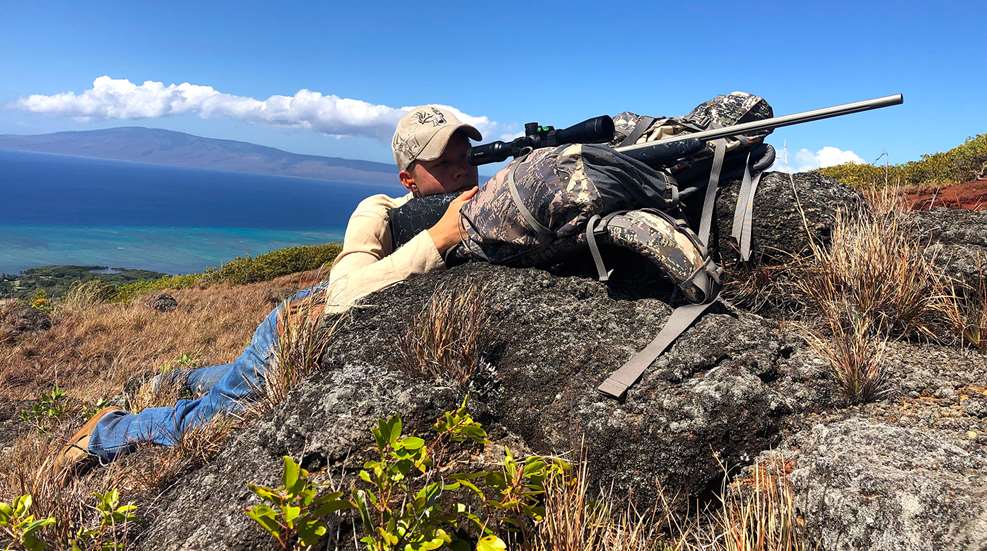
One time in my life—and only one time—I saw a guy shoot a big-game animal from a shooting bench. The buck was feeding across an alfalfa field; he pulled his bench out, got situated and sent a leisurely shot through its vitals. It was … anticlimactic.
Point is, 9,999 times out of 10,000, big game is shot from impromptu, rapidly devised field positions. Rarely, if ever, will there be a bench rest complete with sandbags and swivel-top stool in the perfectly proper location. Which brings to mind a photo I once saw of a hunter sitting in his hot tub, a lush food plot full of deer at his fore, a rifle in one hand and a cold drink in the other. Someday, I want to be that guy. Just once. But I digress.

Prone is the best field position, ever and always. Sitting comes second, followed by kneeling. Standing (or offhand, as the pro shooters call it) comes in dead last. Each position can be radically improved by the addition of support for the firearm, be it bipod, backpack, shooting sticks or convenient tree trunk.
Those details established, it’s also a fact that some hunting regions employ one specific field position almost exclusively. Africa comes to mind; almost all game is shot from the standing position while using cross-sticks for support. This is for good reason; African game territory is usually covered in waist-deep grass and brush, rendering the prone, sitting and kneeling positions impossible. So hunters across the Dark Continent have become adept at squaring their feet, leaning into their sticks, and placing accurate shots on big game from the standing position.
The other side of the spectrum might be Western hunting; a place where game can be scarce, shot opportunities hard-won, and windy distance a factor. Here, most good hunters will go straight to their bellies whenever they can. The prone position, especially when enhanced with a front and rear rest, is the only field position steady enough for truly long, challenging shots.
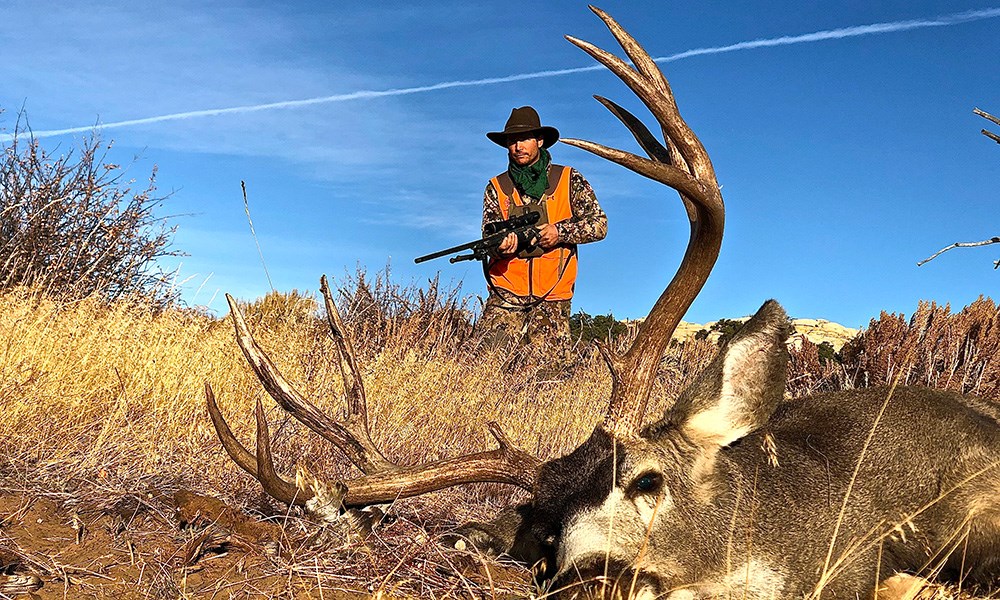
Technique and Training
In this section I’m going to detail how to correctly execute each of the four positions. To train, simply go afield and repeat these instructions, over and over. Make sure you include plenty of dry-fire practice. It’s a great way to build perfect form without breaking the ammo bank.
Prone: To correctly assume the prone position (in the hunting field), glance around and spot a location that will enable you to spread out on the ground, while still providing a view of your target. While glancing you’ll want to notice any un-pleasantries such as cactus, sharp rocks, and rattlesnakes. When you have your spot located, go ahead and get prone. Deploy your bipod, if you have one, or situate your backpack to use as a rifle rest. Settle your rifle on target, and your body flat on the ground behind the rifle. Your legs should be spread, heels laid flat with toes pointing outward. Your support hand (left for right-hand shooters) should be under the buttstock—manipulating a small shooting bag, rolled up sock, or simply your fist—as a rear rest. Your cheek should be snug against the top, or comb, of the rifle stock. Now relax, eliminate all muscular tension, and take a couple deep breaths. Settle the crosshairs, pause your breath in that neutral space between full and empty, and squeeze the trigger. Follow through, eyes open, and try to watch your bullet strike through the scope. Rapidly cycle the bolt and re-acquire the target in case a follow-up shot is necessary. (When dry firing, watch the crosshairs to make sure they stay steadily on target through the click.)
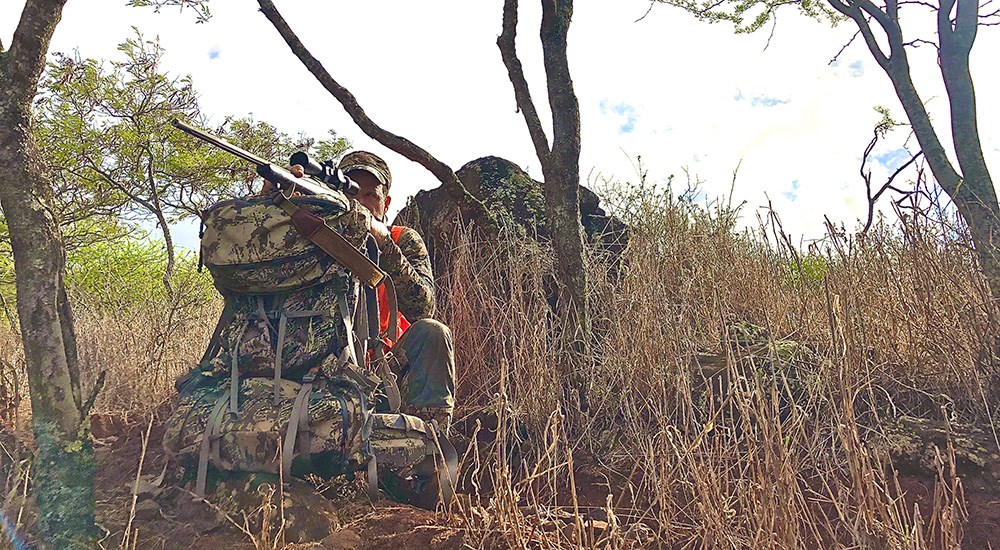
Sitting: At times the prone position is simply not possible. Perhaps there is knee-high grass, or the local terrain is too steep. Whatever the reason, you’re going to have to use the next-best position, which is sitting.
The reason sitting is better than any position but prone is because you have three strong points of contact with Mother Earth; butt, right leg/elbow and left leg/elbow. They form a solid tripod, rendering a reasonably stable platform to support your rifle. To assume the sitting position, first glance around and pick the most ideal location. Drop to your buttocks and quickly grind the soles of your shoes or boots into the dirt to make sure they’re not going to slip around. (This is especially important in steep terrain.) While you’re getting your hind end and feet situated, you should simultaneously shoulder your rifle and settle each elbow onto its corresponding knee. With practice you’ll notice that you need to sit at a slight angle to your target, so that your rifle comfortably points in the correct direction. For a right-handed shooter the rifle barrel will point to between ten o’clock and eleven o’clock. Now relax. If you need to adjust to get the rifle on target, do it by moving your butt or feet, not by shoving the rifle barrel right or left. Once you’re steadily on target and have completed a couple deep breaths, squeeze that trigger.
As I mentioned above, adding a rifle support makes an incredible difference. One of my favorite supports that I almost always have with me while I’m hunting is my internal-frame backpack. Just set it upright in front of your feet and rest the forestock of your rifle on top of the pack. Manipulate the pack with your support hand, lock both elbows atop their knees (super important) and take the shot. You’ll be amazed at how steady you can get.
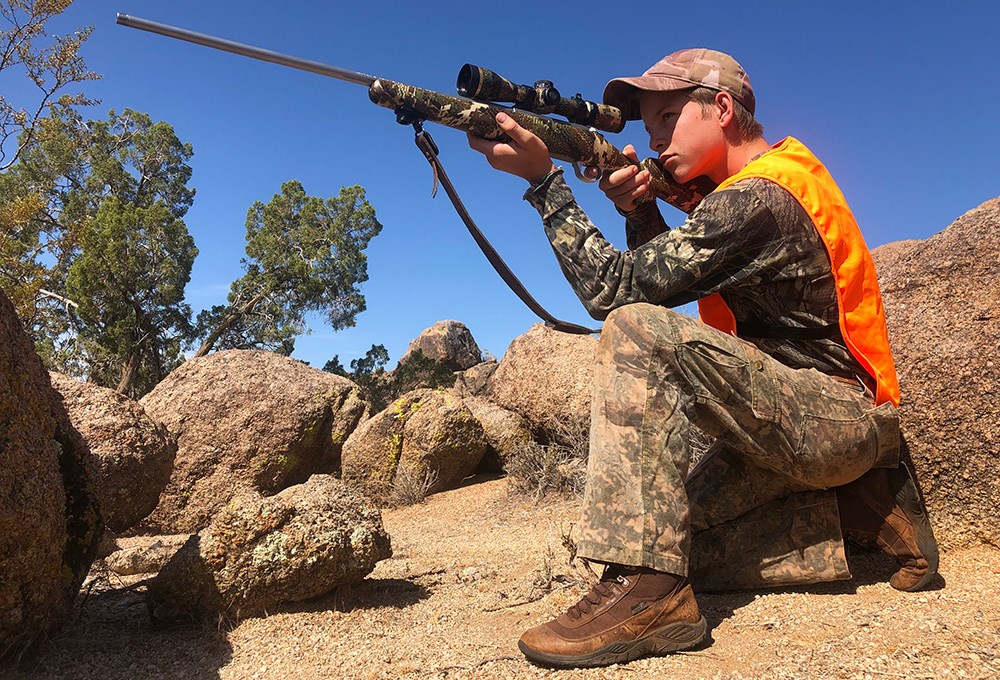
Kneeling: Candidly, the kneeling position doesn’t do much for me. It’s far less stable than sitting because you can only join one elbow and knee. I rarely ever use it. That said, it does have two small advantages; first, it’ll put your rifle barrel slightly higher than will sitting—perhaps two to three inches. If you’re trying to get a shot off and you can’t quite clear the grass or brush from a sitting position, try kneeling. Secondly, folks who cannot physically assume the sitting position due to a disability or a big belly can often use the kneeling position.
To correctly shoot from the kneeling position, drop down to your right knee (right-handed shooter). Sit on your right heel. Prop your left elbow atop your left knee, rifle pointed at the target. Similar to sitting, you’ll want to set up so the target is at ten or eleven o’clock. If possible, use a support of some kind under the forestock of the rifle. Get steady, breath and squeeze the trigger.
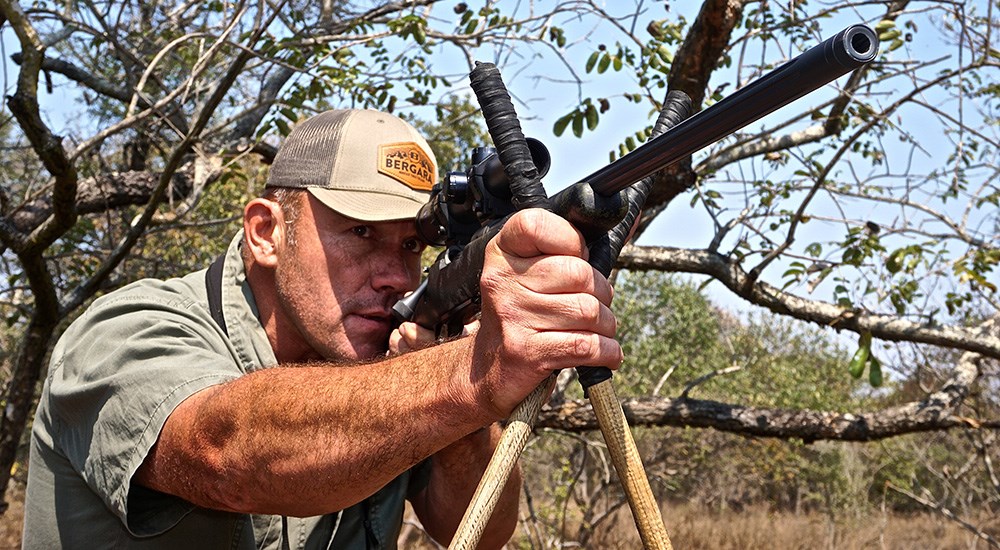
Offhand (Standing): Even though this is the least steady of all positions it has a special place in my heart. Probably because I used to compete in offhand shooting competition, and because I’ve had some awesome experiences hunting in Africa, where the standing position is king.
Since there is so much distance between Mother Earth and our rifle when we draw down on a target from the offhand position, there is a ton of unsteady wobble. We don’t have complete union with the dirt like a prone shooter, we don’t have a tripod like a sitting shooter and we don’t even have a bipod like a kneeling shooter. We’re a one-pod. Mono. And that doesn’t lend itself to accurate shooting. It’s an honest fact that most hunters have no business shooting at game from the standing position. There are exceptions, of course, but for the most part it’s true. So, since we all love to shoot offhand, what can we do to become effective, lethal shots from that position?
Add African shooting sticks. These come in all sizes and shapes, but lets just focus on simple two-piece cross-sticks. You can build your own with a couple long straight sticks or ¾-inch bamboo shoots. Tie or bolt them together about six inches from the top, so that when the bottoms are spread they form an “X.” Wrap the tops with leather or rubber—or not—make them as fancy as you like. Trim the bottoms so that when the sticks are deployed (bottom ends spread roughly three feet) the cross sits at about mid-shoulder level, just right for resting your rifle on.
To shoot well from the sticks you must learn to “square up” your feet and shoot with your rifle trained at almost twelve o’clock. This feels pretty awkward at first, but with practice you can become surprisingly steady. Your support hand (left, for right-handed shooters) will hold and manipulate the union of rifle and sticks. With it you can adjust for elevation simply by lifting or lowering the sticks (narrowing or spreading the feet), and for windage by shifting either the sticks or your feet right or left. Here again, it’ll feel pretty awkward at first, but will quickly become natural. Lastly, don’t stand up straight when shooting from the sticks. Bend at the waist a little, leaning into your rifle and the sticks. Breath, hold steady, and squeeze the trigger.
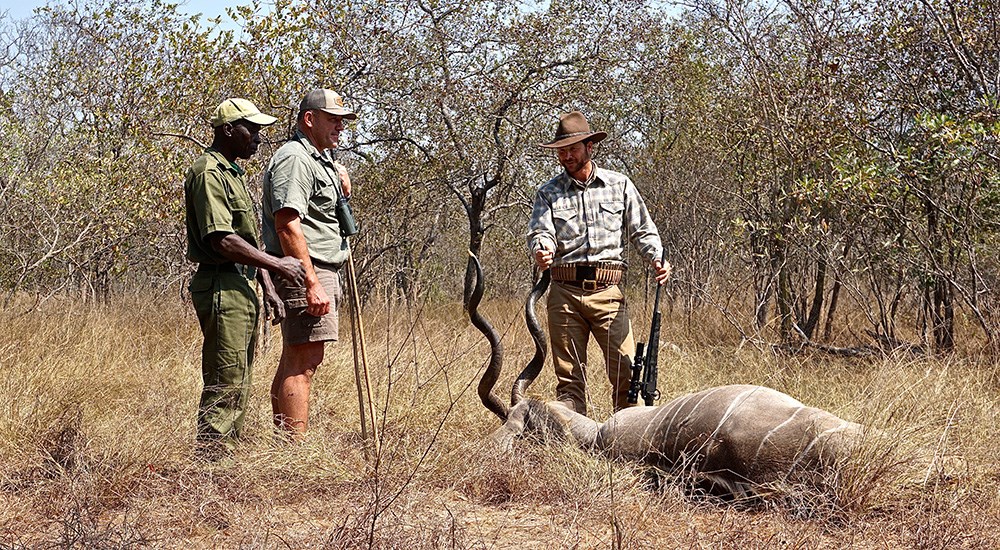
Conclusion
In the final analysis, the two most important elements to making a good shot on game are first, a steady position, and second, a clean trigger squeeze. Use whatever field position will create the steadiest platform for your shot. And if you simply cannot get steady enough, don’t take the shot. Find a better position and try again. When those crosshairs are rock steady, just relax, breath and squeeze the trigger.





































